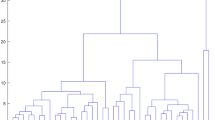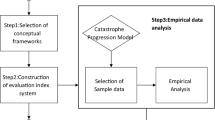Abstract
Based on the research background of the new economic norm and the construction of “non-waste city” in China, this paper studies the coordinated development between the industrial green development system and the regional “non-waste” system of the Yangtze River Economic Zone. First, using the data from 11 provinces from 2013 to 2017 as samples, the comprehensive evaluation index systems for the industrial green development system and the regional “non-waste” system are constructed, respectively. Then, considering the multi-source heterogeneous characteristics of the evaluation index data, the two-tuple linguistic entropy weight method, and gray relational analysis method are applied to filter the evaluation indexes and determine the index weights respectively. Third, combined with the dynamic TOPSIS idea, a new improved coupling coordination degree model is proposed to study the coordination development between the two systems. Finally, an empirical analysis is made, and the result shows that the overall degree of coupling coordination of the two systems shows a fluctuating upward trend. Moreover, the provinces are mainly low-level coupling coordination, and the factors that are hindered in various regions are different.





Similar content being viewed by others
Data Availability
The authors confirm that the data supporting the findings of this study are available within the article.
References
Chen CF, Sun YW, Lan QX, Jiang F (2020) Impacts of industrial agglomeration on pollution and ecological efficiency-A spatial econometric analysis based on a big panel dataset of China’s 259 cities. J Clean Prod 258:120721
Cheng CY, Ge CZ (2020) Green development assessment for countries along the zone and road. J Environ Manag 263:110344
EPS China data (2020) EPS statistical data platform. https://www.epsnet.com.cn/index. html#/Home. Accessed 25 June.
Gan L, Shi H, Hu Y, Lev B, Lan H (2020) Coupling coordination degree for urbanization city-industry integration level: Sichuan case. Sustain Cities Soc 58:102136
Gao MY, Yang HL, Xiao QZ et al (2020) A novel fractional grey Riccati model for carbon emission prediction. J Clean Prod 2020:124471
General Office of the State Council of China (2014) Guiding opinions on promoting the development of the Yangtze River Economic Zone by relying on the Golden Waterway, Beijing.
General Office of the State Council of China (2019) Construction pilot work plan of “non-waste cities”, Beijing.
Grossman GM, Krueger AB (1995) Economic growth and environment. Q J Econ 110:353–378
Herrera F, Martínez L (2000) A 2-tuple fuzzy linguistic representation model for computing with words. IEEE Trans Fuzzy Syst 8(6):746–752
Jiang YG, Chun WD (2018) The application of a new dynamic evaluation method in steelworks’ low-carbon competitiveness. Oper Res Manag Sci 27(12):166–171
Li YF, Li Y, Zhou Y, Shi Y, Zhu X (2012) Investigation of a coupling model of coordination between urbanization and the environment. J Environ Manag 98:127–133
Li P, Rao CJ, Goh M, Yang Z (2021) Pricing strategies and profit coordination under a double echelon green supply chain. J Clean Prod 278:123694
Llop M (2007) Economic structure and pollution intensity within the environmental input-output framework. Energy Policy 35:3410–3417
Mao SH, Zhu M, Wang XP, Xiao X (2020) Grey–Lotka–Volterra model for the competition and cooperation between third-party online payment systems and online banking in China. Appl Soft Comput 95:106501
Mathew M, Chakrabortty RK, Ryan MJ (2020) A novel approach integrating AHP and TOPSIS under spherical fuzzy sets for advanced manufacturing system selection. Eng Appl Artif Intell 96:103988
National Bureau of Statistics of China (2020a) China Environment Yearbook. https://www.yearbookchina.com/naviBooklist-n3019051503-1.html. Accessed 25 June.
National Bureau of Statistics of China (2020b) China Statistical Yearbook. http://www.stats.gov.cn/tjsj/ndsj/. Accessed 25 June.
National Bureau of Statistics of China. (2020c) China education database. http://data.stats.gov.cn/easyquery.htm?cn=C01. Accessed 25 June.
Rao CJ, Yan BJ (2020) Study on the interactive influence between economic growth and environmental pollution. Environ Sci Pollut Res 27(31):39442–39465
Rao CJ, Zhao Y (2009) Multi-attribute decision making model based on optimal membership and relative entropy. J Syst Eng Electron 20(3):537–542
Rao CJ, Goh M, Zhao Y, Zheng J (2015) Location selection of city logistics centers under sustainability. Transp Res Part D-Transport Environ 36:29–44
Rao CJ, Zhao Y, Zheng JJ, Wang C, Chen Z (2016a) An extended uniform-price auction mechanism of homogeneous divisible goods: supply optimisation and non-strategic bidding. Int J Prod Res 54(13):4028–4042
Rao CJ, Zheng JJ, Wang C, Xiao XP (2016b) A hybrid multi-attribute group decision making method based on grey linguistic 2-tuple. Iran J Fuzzy Syst 13(2):37–59
Rao CJ, Goh M, Zheng JJ (2017a) Decision mechanism for supplier selection under sustainability. Int J Inf Technol Decis Mak 16(1):87–115
Rao CJ, Xiao XP, Goh M, Zheng J, Wen J (2017b) Compound mechanism design of supplier selection based on multi-attribute auction and risk management of supply chain. Comput Ind Eng 105:63–75
Rao CJ, He YW, Wang XL (2020a) Comprehensive evaluation of “non-waste cities” based on two-tuple mixed correlation degree. Int J Fuzzy Syst (in press). https://doi.org/10.1007/s40815-020-00975-x
Rao CJ, Lin H, Liu M (2020b) Design of comprehensive evaluation index system for P2P credit risk of “three rural” borrowers. Soft Comput 24(15):11493–11509
Rao CJ, Liu M, Goh M, Wen J (2020c) 2-stage modified random forest model for credit risk assessment of P2P network lending to “three rurals” borrowers. Appl Soft Comput 95:106570
Wang XP, Li YM (2020) Research on measurement and improvement path of industrial green development in China: a perspective of environmental welfare efficiency. Environ Sci Pollut Res (in press). https://doi.org/10.1007/s11356-020-09979-4
Wang JM, Ding H, Zheng H (2018) Research on coordinated development of urbanization in Shandong Province based on improved coupling coordination Model. Sci Technol Progress Policy 35(24):29–35
Wang SJ, Hua GH, Yang LZ (2020a) Coordinated development of economic growth and ecological efficiency in Jiangsu, China. Environ Sci Pollut Res (in press) 27:36664–36676. https://doi.org/10.1007/s11356-020-09297-9
Wang RH, Nan GF, Chen L, Li M (2020b) Channel integration choices and pricing strategies for competing dual-channel retailers. IEEE Trans Eng Manag (in press). https://doi.org/10.1109/TEM.2020.3007347
Wang Z, Zhou HW, Wang XJ (2019) Annual report on development of Yangtze river economic zone (2017–2018). Social Sciences Academic Press, Beijing
Wen JH, Wu CZ, Zhang RY, Xiao X, Nv N, Shi Y (2020a) Rear-end collision warning of connected automated vehicles based on a novel stochastic local multivehicle optimal velocity model. Accid Anal Prev 148:105800
Wen JH, Zhen B, Pu Z, Peng X, Tan J, Shao Z, Bao B, Ran Z, Gao Q, Deng B (2020b) An improved method used for evaluating potential environmental pollution risk based on spatial distribution and density of farms. Environ Sci Pollut Res (in press). https://doi.org/10.1007/s11356-020-11246-5
Wu YQ, Zhu XQ, Gao WJ, Qian F (2018) The spatial characteristics of coupling relationship between urbanization and eco-environment in the Pan Yangtze River Delta. Energy Procedia 152:1121–1126
Wu YL, Zhou F, Kong JZ (2020) Innovative design approach for product design based on TRIZ, AD, fuzzy and grey relational analysis. Comput Ind Eng 140:106276
Xiao XP, Duan HM (2020) A new grey model for traffic flow mechanics. Eng Appl Artif Intell 88:103350
Xiao QZ, Chen L, Xie M, Wang C (2020a) Optimal contract design in sustainable supply chain: Interactive impacts of fairness concern and overconfidence. J Oper Res Soc (in press). https://doi.org/10.1080/01605682.2020.1727784
Xiao QZ, Shan MY, Xiao XP, Rao C (2020b) Evaluation model of industrial operation quality under multi-source heterogeneous data information. Int J Fuzzy Syst 22(2):522–547
Xiao QZ, Shan MY, Gao MY, Xiao X, Guo H (2020c) Evaluation of the coordination between China’s technology and economy using a grey multivariate coupling model. Technol Econ Dev Econ 27:24–44. (in press). https://doi.org/10.3846/tede.2020.13742
Xiao XP, Duan HM, Wen JH (2020d) A novel car-following inertia gray model and its application in forecasting short-term traffic flow. Appl Math Model 87:546–570
Yi PT, Yi Z, Guo YJ et al (2016) A dynamic comprehensive evaluation method embodying development tendency. Oper Res Manag Sci 25(6):175–180
Yuan QQ, Yang DW, Yang F, Luken R, Saieed A, Wang K (2020) Green industry development in China: an index based assessment from perspectives of both current performance and historical effort. J Clean Prod 250:119457
Zhang H, Geng ZR, Yin RS, Zhang W (2020) Regional differences and convergence tendency of green development competitiveness in China. J Clean Prod 254:119922
Acknowledgements
We would like to thank the editor and the anonymous reviewers for their helpful comments.
Funding
This work is supported by the National Natural Science Foundation of China (Nos. 71671135, 72071150), the National Undergraduate Innovation and Entrepreneurship Training Program (No. 20191049714021), and the 2019 Fundamental Research Funds for the Central Universities (WUT: 2019IB013).
Author information
Authors and Affiliations
Contributions
Xiaolu Wang: conceptualization, methodology, writing-original draft. Yawen He: investigation, data curation, methodology, software. Congjun Rao: project administration, supervision, formal analysis, writing–review and editing.
Corresponding author
Ethics declarations
Ethical approval and consent to participate
No ethical approval and patient consent to participate are required for this study.
Consent for publication
The authors confirm that the final version of the manuscript has been reviewed, approved, and consented for publication by all authors.
Competing interests
The authors declare that they have no competing interests.
Additional information
Responsible Editor: Eyup Dogan
Publisher’s note
Springer Nature remains neutral with regard to jurisdictional claims in published maps and institutional affiliations.
Rights and permissions
About this article
Cite this article
Wang, X., He, Y. & Rao, C. Evaluation index system design and coordinated development analysis for the industrial green development system and regional non-waste system in the Yangtze River Economic Zone. Environ Sci Pollut Res 28, 32592–32608 (2021). https://doi.org/10.1007/s11356-021-12807-y
Received:
Accepted:
Published:
Issue Date:
DOI: https://doi.org/10.1007/s11356-021-12807-y




